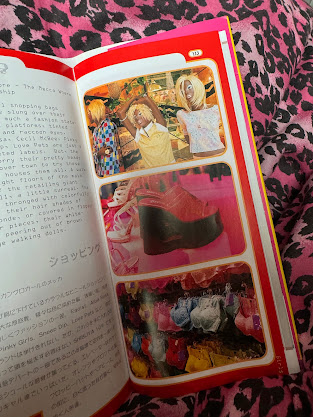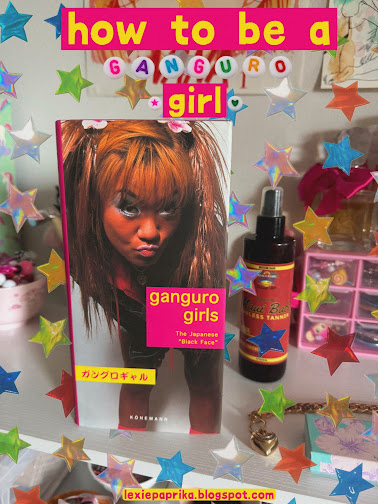"The elevators [of Shibuya 109] are thronged with colorfully dressed Gals, their hair shades of orange or blonde, or covered in floppy hats and hair pieces, their white-painted eyes peering out of brown skin. Strange walking dolls." Kate Klippensteen, page 132
WHAT IS A GANGURO?
Dark tans, flashy makeup, and bleached hair. The word ganguro (ガングロ) describes an early substyle of gyaru that existed from the mid-90s to about 2008 (as estimated by Kubo Yuka in her book The Last Moments of the Ganguro Tribe: A Study of Gyaru Culture). They were inspired by American fashion, notably California surf culture, but by the 1990s, they evolved into something uniquely Japanese.
These ganguro were largely middle-class teens and twenty-somethings with disposable income. They hung out in Shibuya, shopped at Shibuya 109 (Marukyu), frequented Para Para dance clubs and Karaoke booths, ate fast food, and gabbed with like-minded friends. They had fun.
In 2000, Tokyo-based writer Kate Klippensteen and photographer Everett Kennedy Brown collaborated on a book called Ganguro Girls. The book includes images of real-life Ganguro, a small questionnaire filled out by each of the girls, and brief but astute blurbs about the subculture by Klippensteen. It's an intimate snapshot of this short-lived (and my personal favorite) period of gyaru.
A lot can be learned from these primary sources. Let's dig in and see what we can find...
 |
My copy of Ganguro Girls
|
THE LOOK
"Ganguro Gals reminded me of drag queens, anime heroines, messed up Barbie dolls..." Kate Klippensteen, page 5
- Bleached hair in blonde, tea-brown (a trendy color among Amura), silver and orange
- Hair pieces and wigs (a lifesaver if you don't want to bleach your hair)
- Long side bangs clipped with bobby pins and barrettes
- Straightened bangs paired with textured/teased out/wavy hair
- Black or blue (and sometimes silver or dark purple) eyeshadow on the lid
- White shadow or a soft, workable liner that highlights the brow bone and aegyo sal
- Thinner eyebrows with a defined arch
- False upper eyelashes (at the time, lower falsies weren't particularly popular, and natural lower lashes were defined with black mascara)
- White or frosted lips
A tan is essential to ganguro.
It can be achieved at a tanning salon or by layering self-tan lotions. This is where the distinction between the terms ganguro and gonguro originated. Ganguro was used for a gal who tanned naturally (via sun beds or beach trips), and gonguro were those who used lotions.
These days, the term gonguro isn't really used, and if it is, it's interchangeable with ganguro.
- Ten to twelve-inch platform boots in white, pink, black, or brown.
- Or equally tall wooden platform sandals.
* Sandals and boots can be worn as is or paired with long socks (typically black, although it wasn't uncommon to match the color to another element of your coordinate)
- Chunky sneakers paired with scrunch socks or leg warmers (typically white)
- Tennis, baby doll, and shift dresses in bright colors and soft materials
- Straight mini skirts or knee-length skirts with tropical, silk-printed motifs (often from brands like Alba Rosa and MeJane)
- Polo shirts, tank tops, and t-shirts with logos from coveted Marukyu labels.
- Shorts
- Denim
- Bright, solid colors
- Floral (tropical)
- Outwear like hoodies, parkas, and trench coats in vibrant, primary colors
- Long black leather and denim coats were also popular
Of course, this doesn't cover everything, but these were some of the items I noticed repeated in the book. One thing's for sure: ganguro is colorful.
"We are bright, not just on the surface but also deep inside." - Hitomi, featured on pages 56 and 57
- Colorful nails
- In the mid to late 90s (and the very early 2000s), nails weren't nearly as long or decorated as what became standard for many kuro gyaru in the following years.
- You'll notice that many of the girls wear their nails naturally or with simple polish. This is most likely because many were high school students and had to follow a dress code.
- Wooden bauble necklaces and bracelets
- Bangles in silver (gold and colors are also seen)
- Small oval (very 90s) sunglasses or rounded, white 60s-esque sunnies
- Hawaiian-inspired jewelry and accessories (think pieces featuring kukui, hibiscus, shells, plumeria, etc.)
THE LIFESTYLE
"I truly grew to admire their carefree and open approach to living, in a country where rules abound and can be quite oppressive." Kate Klippensteen, page 7
How do you live the life of a ganguro? The most honest and straightforward answer is to have fun and be yourself.
That being said, ganguro was as much a culture as a fashion style, and like many other subcultures born of a particular time and place, it was associated with distinct activities and hangout spots. Klippensteen lists some of these favored hangouts as Para Para dance clubs, Karaoke bars, Burger Kings and other fast food joints, a crepe stand, or an amusement center.
Para Para was a standout activity, which is unsurprising given that it's still widely associated with gyaru today. Back in the ganguro's heyday, they didn't have YouTube tutorials, so many would pay 3,800 yen for step-by-step instructional videos. They'd take these learned moves to the clubs, but it wasn't unusual for the girls to ad-lib.
Shopping was also big...unsurprisingly. Marukyu was the holy mecca of ganguro. As of 2000, when this book was created, some of the shops frequented by the gals were Alba Rosa, Egoist, Cecil McBee, Pinky Girls, Love Boat, Love Pets, and Sneep Dip.
Remnants of these stores can be found on e-thrifting sites like Mercari JP, or, in the case of Egoist, a physical store remains in Marukyu today. However, the merchandise is alien to what would've been sold in 2000.
Alba Rosa has undergone a renaissance as of late, due to a renewed interest in gyaru and the resurgence of Y2K and Heisei-era aesthetics. Their iconic blanket coat (seen above) has become one of gyaru's most recognizable symbols, so much so that it has become visual shorthand for '90s to early 2000s gyaru as a whole.
Alba Rosa may have started as resort casual attire for adults, but it is now inextricable from gyaru.
Several photographs of the girls carrying vinyl shopping bags from then Marukyu housed labels like Idol (stylized with a heart for the 'O') and Alba Rosa are featured.
HOW TO BE A GANGURO GIRL
"[Ganguro] have chosen living for the moment, over being isolated, bullied or depressed at school...They would rather put on a flamboyant outfit and hang out with their many friends than worry about tolling away at boring studies or jobs." Kate Klippensteen, page 6
Now that the gyaru revival is upon us, I'd like to compile a list of what is needed to create that peak ganguro look, based on the knowledge we garnered from Kate Klippensteen's book. The style will undoubtedly vary in the modern age, given that many classic brands are now defunct and sell secondhand for exorbitant prices on e-commerce sites.
But this is a good place to start as you decide what ganguro means to you.
A Tan
A tan complexion is a non-negotiable for ganguro. When tanning, remember to consider your natural skin tone. While the term ganguro is derived from Chinese characters that literally translates to "blackface," that's not what we're trying to achieve here.
White Eyeshadow
Whereas nowadays, the iconic "
droop" (tarume) has become the key point of most gyaru makeup, for the ganguro, the white-painted eye
defined the look.
Blue or black shadow was patted on the lid and then outlined with white in an almost reverse raccoon eye. In my opinion, the white on the aegyo sal is the most important part.
Tropical-inspired Accessories and Motifs
Thanks to labels like Alba Rosa, Roco Nails, and MeJane, tropical patterns are a popular addition to any ganguro coordinate. Hibiscus and plumeria hair clips, Kukui bracelets and necklaces, palm tree patterns on skirts and dresses... Once you start looking for it, you'll see it everywhere.
American surf lifestyle brands like Roxy were also popular.
A-Line Silhouettes
By about 2005ish, when Y2K was in full swing, tiered mini skirts were commonly worn by gyaru. However, during the heyday of the ganguro, it was all about the straight skirt and dress.
Platforms
Whether it's boots, sandals, or sneakers, a shoe with (often towering) height is the way to go. In Kate Klippensteen's book, none of the girls featured wore flat shoes. Not one.
Have Fun
I know this sounds like something a mom tells their kindergartener before they head off to school, but it's true. The crux of the ganguro attitude is being yourself. Unapologetically.
"In their somewhat hippie-like world, there is no hierarchy, no ill will. And these gals, like everyone else, want to have FUN. The difference is they do." - Kate Klippensteen, Tokyo, Summer 2000


























No comments:
Post a Comment